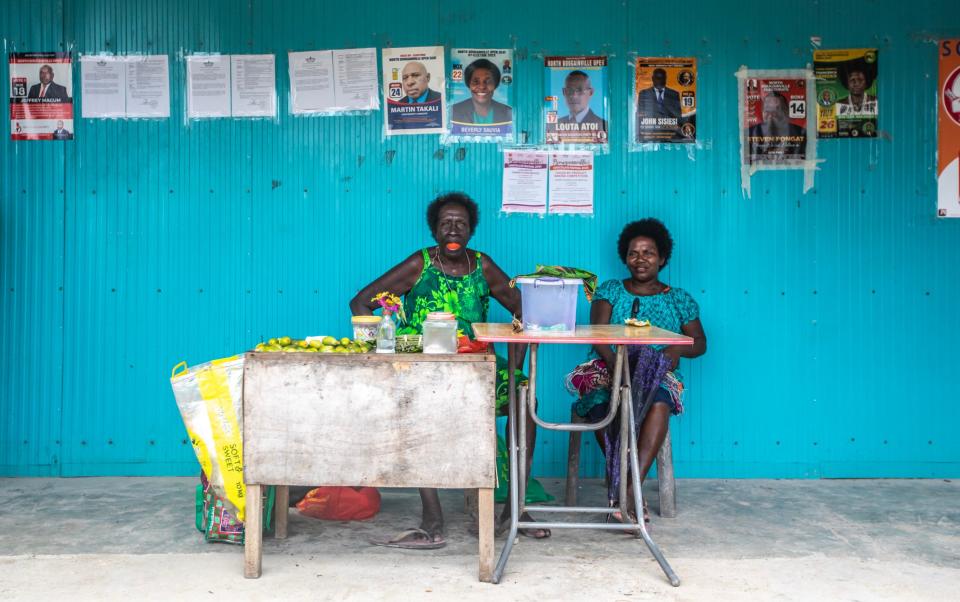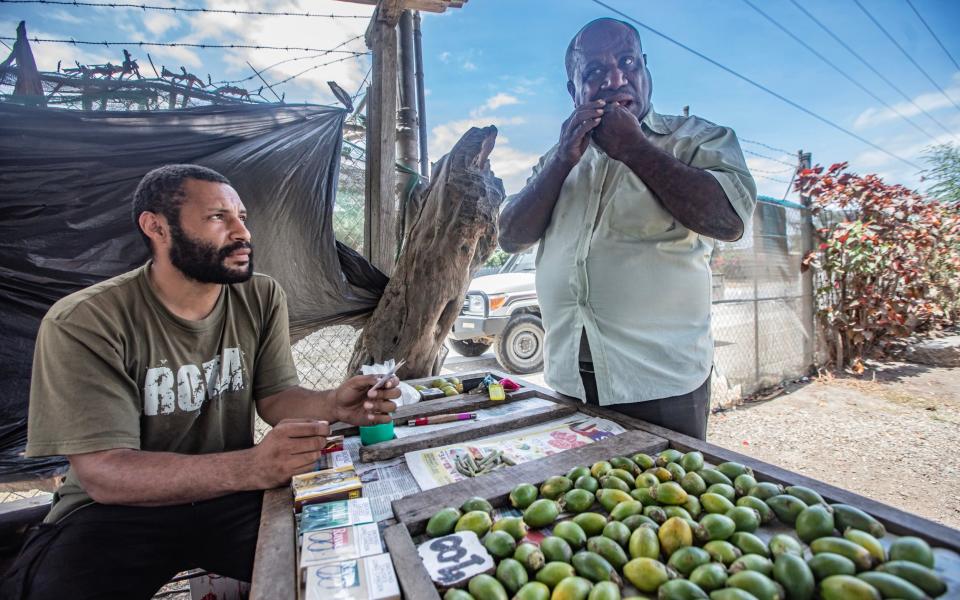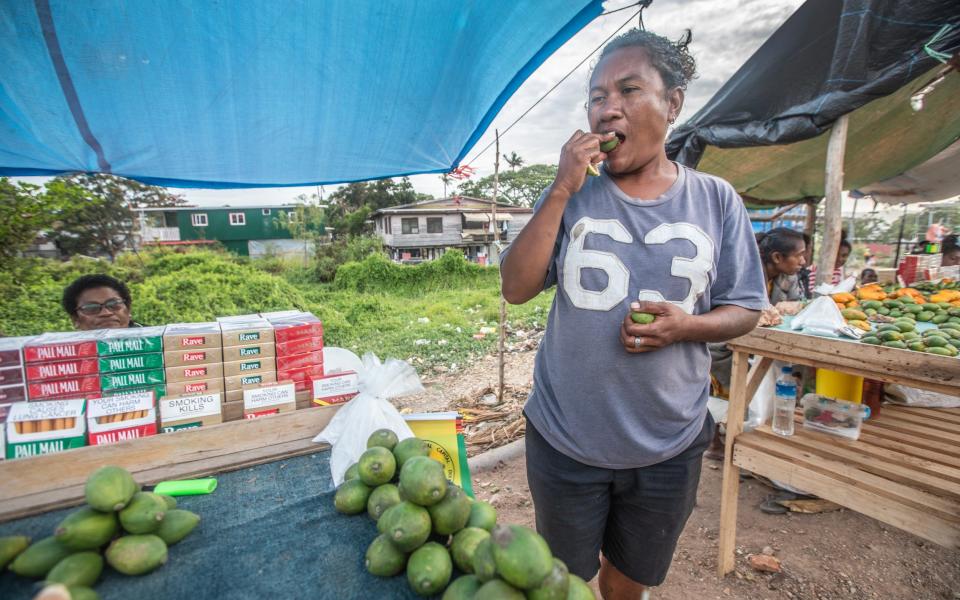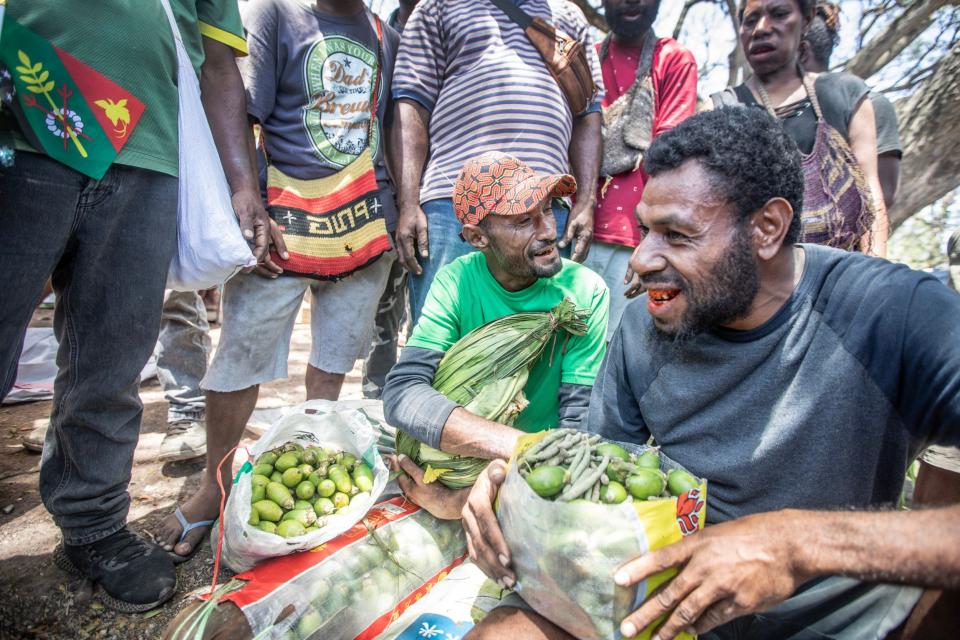David Taim, a civil servant in Port Moresby, the capital of Papua New Guinea, always starts the day the same way.
He bites into a green, unripe nut, as well as the inflorescence of a pepper plant and some white powder, mostly slaked lime. He then chews the mixture.
“It opens your eyes. It wakes you up. It brings your senses to life,” he says.
“If I don’t have palm nuts during my working hours, my work for the day is over.”
Betel nut is not very well known in the western world. However, this addictive nut that grows on the areca palm is considered the fourth most widely used psychoactive substance in the world after caffeine, nicotine and alcohol.


According to oft-cited but imprecise estimates, 600 million people, including Taim, chew regularly. The fact that hazelnut production worldwide has more than doubled in the last 20 years shows that this chewing habit has undoubtedly become widespread and even more popular.
Consumers are located in the Indian subcontinent, South Asia and Melanesia, regions where the tradition of chewing nuts has a history dating back thousands of years.
Chewing styles vary greatly. In India, the world’s leading producer, it is sold in ready-made, mass-produced packages containing hazelnuts, slaked lime, various flavors and often tobacco blends. In the chamorro people of the Mariana Islands, it is ripe and hard, chewed and swallowed without any additives.
However, no matter how hazelnuts are consumed, they provide the same soft, warming feeling of enthusiasm and alertness. And that’s what makes it so popular.
There’s no doubt that David Taim loves palm nuts. He carries his daily rations in a plastic bag, and his light-coloured shirt bears stains of red saliva, which he had to constantly spit out as he chewed the betel nut mixture. Like many people in Papua New Guinea, he started chewing areca nuts when he was three or four years old.


“We are growing with betel nut culture. When we start eating hard foods, we also start chewing. “It has always been a part of me,” he says.
The addiction means he can buy up to 40 nuts some days, which is a big expense. Frequent business trips to non-chewing countries can sometimes create problems. The first thing he does when he arrives in a new country is to find betel nut sellers.
“While in Dubai I found Indians to buy at inflated prices. “When I went to Berlin, I smuggled hazelnuts, but the stock lasted only a week,” he says.
However, the deliciousness of chewing also comes with a price. Another part of the world that consumes betel nuts is the Northern Mariana Islands in the Western Pacific. In 2018, American ear, nose and throat and head and neck surgeon William Moss arrived here for a job at the local hospital. He couldn’t believe what he saw.
“I quickly realized that the patterns of oral cancer were not like those in the western world. Patients are presenting with advanced disease, they are generally younger, the outcomes are terrible, and the incidence is through the roof. “This is completely disproportionate,” he says.


As early as the beginning of the last century, medical experts in India began to suspect a link between betel nuts and cancer. Until the 1980s, the scientific community was still debating whether nuts were carcinogenic; This was largely because users often confused them with tobacco and their effects were difficult to distinguish.
But in the ’90s and early 2000s, more and more studies showed a clear link, including studies in Taiwan, where hazelnuts were often chewed without tobacco.
This eventually led the International Agency for Research on Cancer, an agency of the World Health Organization, to officially classify betel nut as a group 1 carcinogen in 2004. Over the past 20 years, there have been a number of new studies, many of them recent. There is a very clear connection between these.
Lip and mouth cancer is not among the ten most common cancer types worldwide. However, it is much more common in tropical Asian and Pacific countries where betel nuts are consumed.


In Papua New Guinea, where the majority of the adult population chews betel nuts, the per capita oral cancer rate is the highest in the world. It is also the most common type of cancer in men and the second most common in women.
In a country with a weak healthcare system and few specialist doctors, many people are likely to die before being diagnosed. In the Northern Mariana Islands, which has a more robust healthcare system, those affected have a better chance. However, betel nut still causes a lot of harm to public health. And it’s not just about cancer.
“There is a growing list of systemic problems with betel nuts. Heart problems, kidney, liver, negative outcomes in pregnancy. The story that emerges is that betel nut should actually be considered in a similar way, independently of alcohol and tobacco,” says William Moss.
In the Northern Mariana Islands, most betel nut chewers are still unaware of the risks, as a survey study in which Moss was involved showed. “Surprisingly, 87 percent of 300 chewers did not know that betel nuts were carcinogenic,” he says. .
Two decades after betel nut was classified as a carcinogen, sales in many parts of the world are still poorly regulated and there are few warnings about its health risks. Moss argues that this is reminiscent of the situation with tobacco in the middle of the last century, when sales were unregulated even though the health risks were known.
“It took a collective international effort to bring big tobacco to the table and hold them accountable. “We have another strong billion-dollar industry here, but the target consumers are marginalized, poor populations with minimal education,” he says.


As the sun sets in Port Moresby, Taim heads to the betel nut market to find tomorrow’s rations.
Margret Tarube Teka works at one of the many stalls. Like many people, he is financially dependent on hazelnuts, the country’s most important domestic crop. “I have no other way to earn a living, but palm nuts provide a good income. This is our gold,” she says.
He sells two types of carcinogens at his stall: cigarettes and palm nuts. The first carries the usual labels: “Smoking kills”, “Smoking causes lung cancer”. The latter is sold without any warning.
But in 2013, local authorities in Port Moresby did something unusual. An attempt was made to completely stop the betel nut trade. Partly because of the cancer risks, but mostly because of the garbage and red spit splattered on the streets.
Besides leaving an unpleasant impression of the city, spitting is also believed to contribute to the spread of tuberculosis, a disease that has a strong presence in Papua New Guinea.


The National Capital Region Betel Nut Control Act of 2013 prohibited the sale, consumption, and spitting of betel nut in public places and the transportation of more than 2 kilograms per person into the capital. This was a devastating blow to many people who made their living in business.
“I started smuggling by the sea,” admits Margret Tarube Teka. “I had no other choice.”
In 2017, the ban was lifted following intense criticism and reports of police officers harassing and assaulting betel nut sellers.
However, in 2023, some minor restrictions were re-imposed on the practice, with Port Moresby’s Boroko district declaring a palm nut-free zone. Margret Tarube Teka’s condition is critical. “How will we live if they stop this? This is our only source of income,” she said.
But there may be a way other than harsh laws to curb and control millions of people’s appetite for palm nuts.
Thaddeus Herzog is trying to find this route 6,500 kilometers from Port Moresby. He serves as an associate professor at the University of Hawaii Cancer Center and devotes a significant portion of his time to betel nut research.
“There is relatively little research compared to alcohol and tobacco. “I think this is partly because betel nuts are not commonly chewed in the West,” he says.


Herzog’s research focuses on cessation programs. There is a wide range of help available for a smoker to overcome addiction. But it’s not for betel nut chewers. Herzog and his colleagues designed a psychological behavioral program to help chewers stop chewing.
“We are following the lead of smoking cessation research, but technologies developed to help smokers quit need to be adapted. “It’s a different substance and different cultures.”
But often, motivating people to quit arec nuts is more difficult than smoking. “Many people are unaware of the link to oral cancer. In many areas where betel nut is chewed, its health risks are not fully assessed,” he says.
A pharmacological aid for smokers, such as nicotine replacement therapy, would likely make smoking cessation programs more effective. However, there are no approved pharmacological treatments available today. “This research is several decades behind where smoking research is now,” Herzog says.
Officer Taim would definitely benefit from such assistance. He managed to quit smoking a year ago. But giving up nuts was harder for Taim, even though his own father, who had oral cancer when he was a young child, was a warning example. He was lucky to survive.
“He resigned after that,” says Taim. “But I can’t give up the hazelnuts. “I tried many times, but the longest break was a week.”
Protect yourself and your family by learning more about Global Health Security.